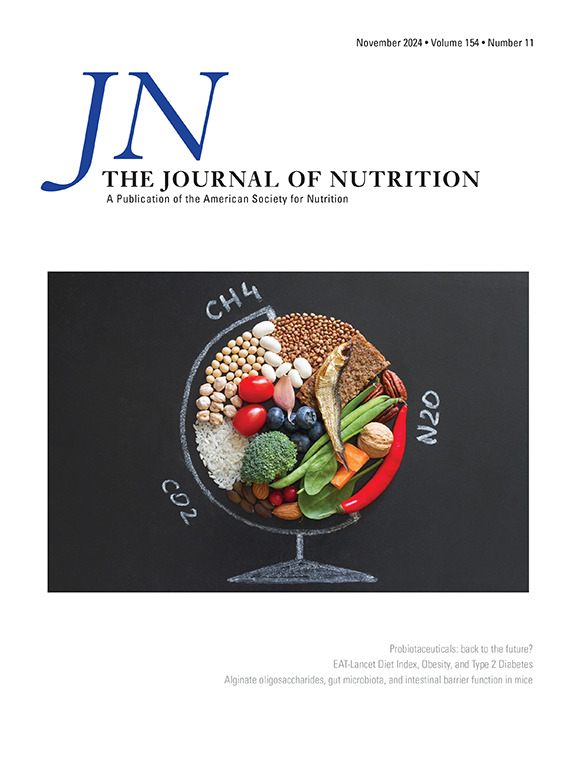利用非酯化 DHA 和花生四烯酸 (ARA) 氧脂和脂肪酸估算膳食 α-亚麻酸 (ALA) 需求量的方法。
IF 3.7
3区 医学
Q2 NUTRITION & DIETETICS
引用次数: 0
摘要
背景:膳食中对 ALA 的需求量仍不明确,这种必需脂肪酸(FA)的每日允许摄入量(RDA)缺失就证明了这一点。在以前的研究中,我们观察到,最大限度地提高非酯化(NE)DHA 氧脂所需的膳食 ALA 量似乎高于最大限度地提高组织酯化 DHA 水平所需的量,而酯化 DHA 通常被用来估算 ALA 的需要量。此外,我们还观察到膳食中的 ALA 会减少酯化花生四烯酸(ARA)及其 NE 氧脂:由于 NE 氧脂素和 FA 介导了 FA 的生物活性,我们研究了这些 DHA 和 ARA 池是否可用于确定膳食中的 ALA 需求量:每 100 克以 AIN93G 为基础的膳食为 9 组 4 周大的雄性 Sprague-Dawley 大鼠(n=5)和 10 组雄性和雌性 CD1 小鼠(n=6)提供 0.1 至 2.5 克 ALA 和 2 克亚油酸。对血清、肝脏、肾脏和脑匀浆中的 NE DHA 和 ARA 及其氧脂素进行固相萃取,并通过 HPLC-MS/MS 进行定量。采用分段回归法对从增加到高原的转变进行断点分析:结果:随着膳食中 ALA 含量的增加,血清、肝脏和肾脏(而非大脑)中的 NE DHA 氧脂素和 DHA 最初迅速增加,然后趋于平稳,而 ARA 氧脂素和 ARA 则趋于减少和趋于平稳。因此,计算出了 DHA/ARA 和羟基-DHA/羟基-ARA(DHAOH/ARAOH)比率的断点,这些比率由通过两种 FA 的共同途径合成的氧脂组成。在血清、肝脏和肾脏中,最高估计断点表明 ALA 需求量为每 100 克膳食 0.7 克(1.7%能量),约为之前估计值的两倍:本研究支持使用NE DHAOH/ARAOH或DHA/ARA作为ALA需求量的生化指标。在大鼠和小鼠身上应用这种方法表明,ALA 的需求量高于之前仅使用酯化 DHA 估算的需求量。本文章由计算机程序翻译,如有差异,请以英文原文为准。
A Method to Estimate the Dietary α-Linolenic Acid Requirement Using Nonesterified DHA and Arachidonic Acid Oxylipins and Fatty Acids
Background
The dietary requirement for α-linolenic acid (ALA) remains unclear, as evidenced by the absence of a Recommended Dietary Allowance (RDA) for this essential fatty acid (FA). In previous studies, we observed that the amount of dietary ALA required to maximize nonesterified (NE) DHA oxylipins appears to be higher than the amount required to maximize tissue esterified DHA, which have classically been used to estimate the ALA requirement. Further, we observed that dietary ALA reduces esterified arachidonic acid (ARA) and its NE oxylipins.
Objectives
Since NE oxylipins and FA mediate the biological activities of FA, we examined whether these DHA and ARA pools could be used to determine the dietary ALA requirement.
Methods
Nine groups of 4-wk-old male Sprague-Dawley rats (n = 5) and 10 groups of male and female CD1 mice (n = 6) were provided 0.1–2.5 g ALA and 2 g of linoleic acid per 100 g of AIN93G-based diets. NE DHA and ARA and their oxylipins in serum, liver, kidney, and brain homogenates underwent solid phase extraction and were quantified by HPLC-MS/MS. Breakpoint analysis of transitions from increase to plateau was conducted using piecewise regression.
Results
In response to increasing dietary ALA, NE DHA oxylipins, and DHA in serum, liver, and kidney (but not the brain) initially increased rapidly and then reached a plateau whereas ARA oxylipins and ARA tended to decrease before reaching a plateau. Thus, breakpoints were calculated for the ratios of DHA/ARA and hydroxy-DHA/hydroxy-ARA (DHAOH/ARAOH), which consisted of oxylipins synthesized via pathways common to both FA. In serum, liver, and kidney, the highest estimated breakpoint indicated an ALA requirement of ∼0.7 g/100 g diet (1.7% energy), approximately twice that of previous estimations.
Conclusions
This study supports the use of NE DHAOH/ARAOH or DHA/ARA as biochemical indicators of the ALA requirement. Applying this method in rats and mice indicates that the requirement is higher than previously estimated using esterified DHA alone.
求助全文
通过发布文献求助,成功后即可免费获取论文全文。
去求助
来源期刊

Journal of Nutrition
医学-营养学
CiteScore
7.60
自引率
4.80%
发文量
260
审稿时长
39 days
期刊介绍:
The Journal of Nutrition (JN/J Nutr) publishes peer-reviewed original research papers covering all aspects of experimental nutrition in humans and other animal species; special articles such as reviews and biographies of prominent nutrition scientists; and issues, opinions, and commentaries on controversial issues in nutrition. Supplements are frequently published to provide extended discussion of topics of special interest.
 求助内容:
求助内容: 应助结果提醒方式:
应助结果提醒方式:


